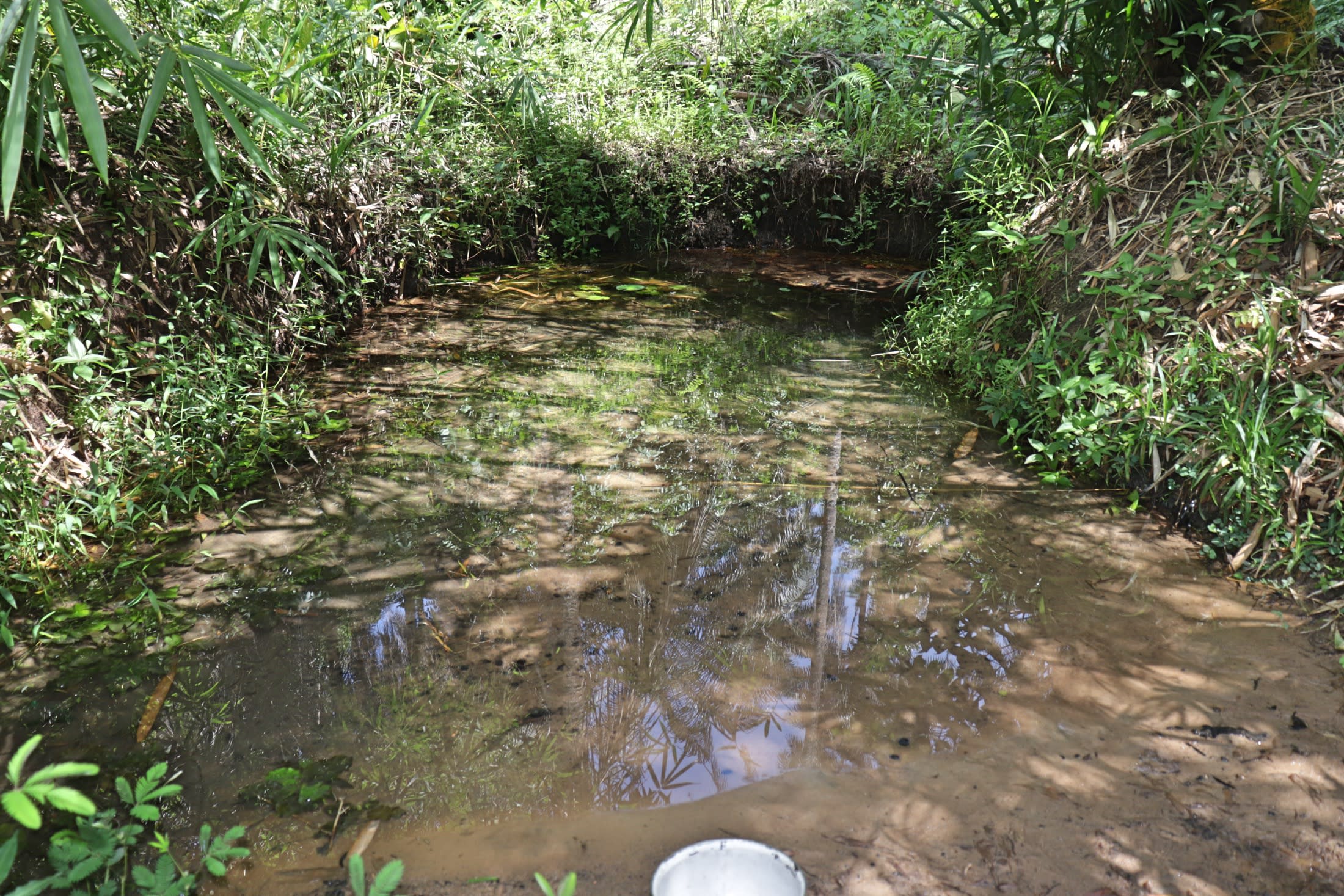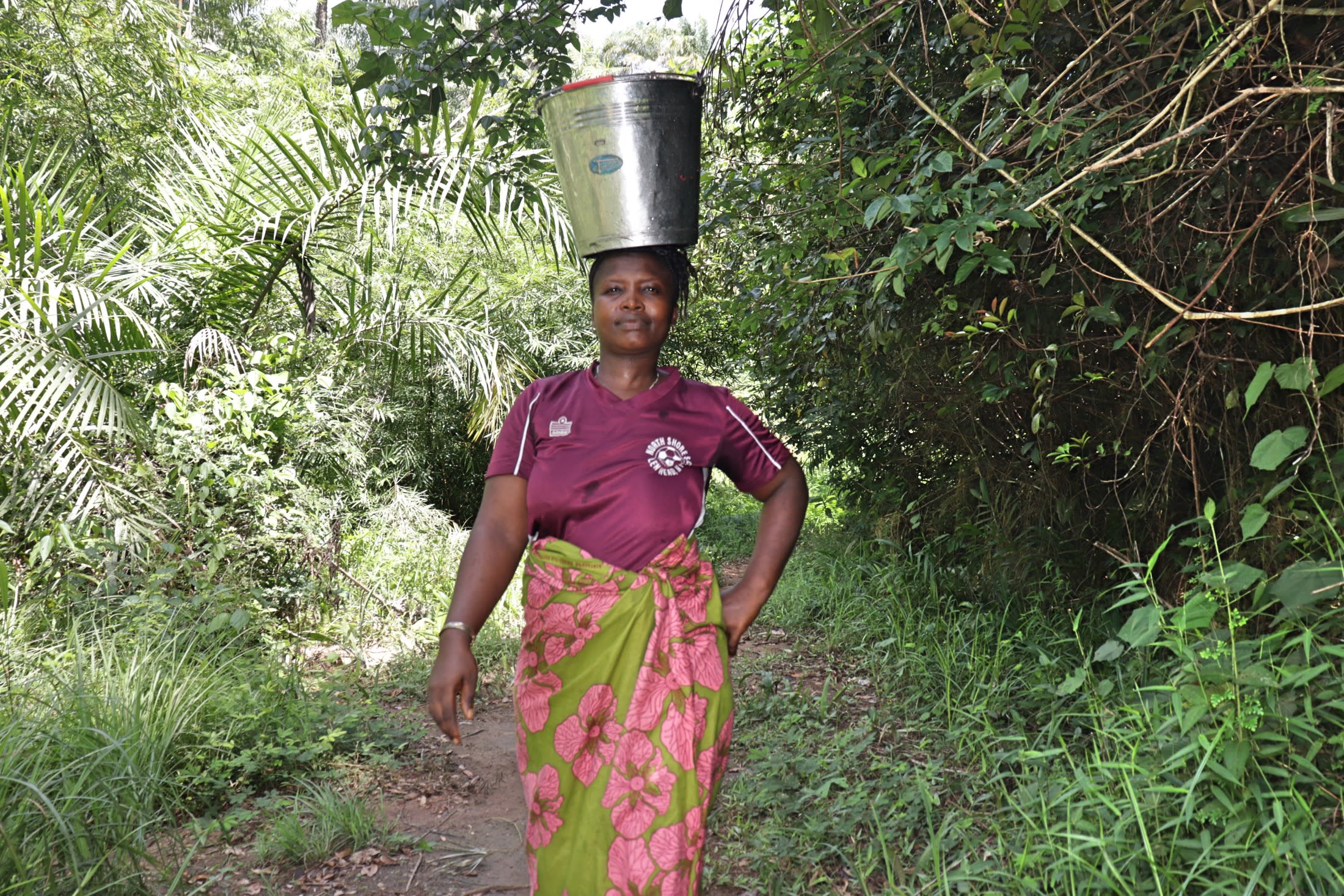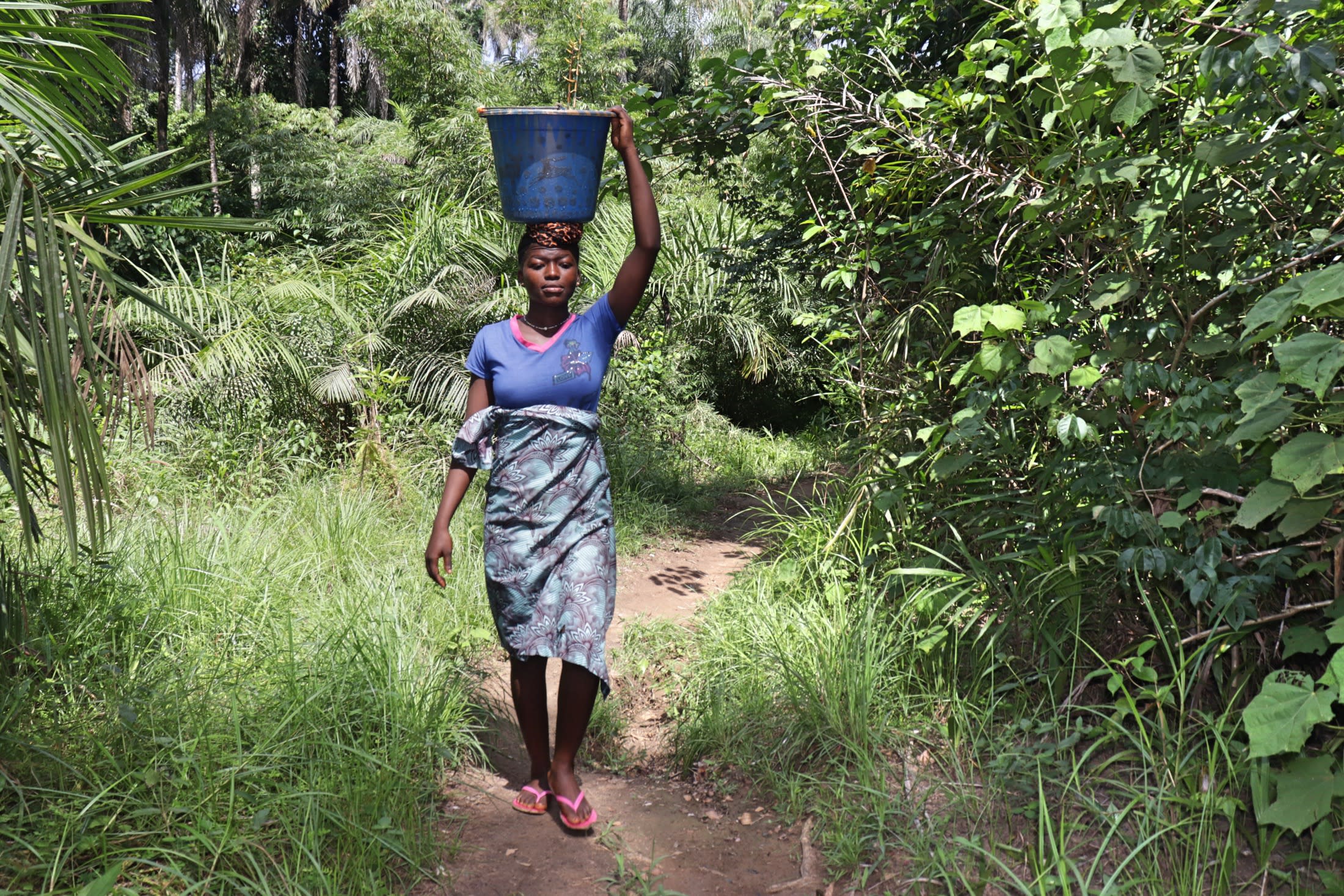February, 2024: Kayrefay Community New Well Complete!
We are excited to share that there is now a safe, reliable borehole well at Kayrefay Community. As a result, community members no longer rely on unsafe water to meet their daily needs. We also conducted hygiene and sanitation training, which focused on healthy practices such as handwashing and using latrines.

Celebrating clean water!
"This water point is a blessing for me as a school-going girl. Thank you for this goodness in my community," said 15-year-old Maseray K.
"I always faced punishment in school because of my lateness, and the distance from my community to the school is too far, and I always walk to school. Sometimes, I am even absent from school because by the time I finish fetching water [I] am already late for school. But now that we have this water point in our community, I will no longer go to school late. No more going to the stream in search of water," Maseray said.

Maseray splashing.
"With this water point in my community, I believe my educational goals will now come to pass. I will now achieve my plans, like always going to school early, always being present in school, have enough time for my studies," she concluded.
"I'm very happy for this water point in my community because we have suffered for so long in terms of having safe drinking water. The swamp water is not pure to perform ablution, let alone to drink," said 30-year-old farmer Koyah Conteh.

Koyah splashing clean water.
"Now that this water point is in my community, [I] am so glad because my children will no longer go to the stream to fetch contaminated water. I used to wake my children to go in search of water at the stream because if you don't go to the stream very early, the water will get dirty by other community members that went to the stream early. But now that we have this water point in our community, all our constraints are over. My children will now go to school early. They will not face any punishment from their teachers. I also will prepare food for my family early. I will now spend enough time at the market to sell all my goods," continued Koyah.
"I now have access to water that is clean. I do believe that my health will no longer be affected. The money I used to spend to buy medication or go to the hospital will be used to do something else. I want to take this opportunity to thank you for this water point in our community. You are our life savers. May God bless you all," concluded Koyah.
We held a dedication ceremony to officially hand over the well to the community members. Several local dignitaries attended the ceremony, including Mr. Abu Bakarr Bangura, a Port Loko District Council representative, and Mr. Osman Fofanah from the Ministry of Water Resources. Each official gave a short speech thanking everyone who contributed to this water project and reminding everyone to take good care of it. Then, Koyah and Maseray made statements on their community's behalf.

Celebrating!
Field Officer Fatmata Kalokoh said the community members sang various songs in their local languages, Krio and Temne. Dancing was a part of their celebration, too. The other community members used empty rubber containers as musical instruments. The children participated excitedly during the dedication. They clapped and sang the songs with the rest of the crowd.
New Well
The drill team arrived the day before beginning work. They set up camp and unpacked all their tools and supplies to prepare for drilling the next day. The community provided space for the team to store their belongings and meals for the duration of their stay.
The next day, the team began to drill. We reached a final depth of 18 meters. The team did a soil test and forcefully pumped clean water into the well to remove any dirt and debris from the drilling process.

Drilling.
Next, the team bailed the well and flushed it, clearing any debris generated by the drilling process. This well has a static water level of 8 meters. Finally, we tested the yield to ensure the well would provide clean water with minimal effort at the pump.

Chlorination.
As the project neared completion, we built a cement platform, walls, and drainage system around the well to seal it from surface-level contaminants. The drainage system helps to redirect runoff and spilled water to help avoid standing water at the well, which can be uncomfortable and unhygienic and a breeding ground for disease-carrying mosquitoes.

Installing the pump.
At last, we installed the pump and conducted a water quality test. The test results showed that this was clean water fit for drinking! After that, we contacted the community to schedule the dedication for the well.
New Knowledge
Before conducting any hygiene training, we called and visited the local water user committee to understand the community's challenges and lack of sanitation facilities. We shared the findings from our discussions with the committee members to help them make the necessary adjustments before the training began. For example, we identified households without handwashing stations or ones that may need to repair their latrines. With this information, community members worked together to improve hygiene and sanitation at home.
After this preparatory period, we scheduled a time when members from each household using the water point could attend a three-day hygiene and sanitation training. We then dispatched our teams to the agreed-upon location to hold the meeting.
Trainers Fatmata Kalokoh and Hemore Nyuma shared that the training was held at the headman's compound, which the community people chose because the area is convenient for them. Before the team's arrival each day, the members of the Water User Committee made sure the gathering area was clean and that there were benches, chairs, and tables set up.
There were 101 participants present over the three days of training.

Dental hygiene sesssion.
Training topics covered included handwashing and tippy taps, good and bad hygiene habits, teen pregnancy, worms and parasites, proper dental hygiene, menstrual hygiene, proper care of the well's pump, keeping the water clean, the cost recovery system, the importance of using dish racks and clotheslines, the importance of toilets, keeping latrines clean, balanced diets, the diarrhea doll, and disease transmission and prevention (including COVID-19, Ebola, Hepatitis, HIV and AIDS).

Learning about disease transmission.
One of the most memorable topics discussed was the need for women to receive prenatal care and experience safe deliveries at nearby health facilities instead of relying on traditional herbs.
One courageous participant, N'mah Kargbo, shared her story. "Two months after I got married. I got my first pregnancy. So, my husband took me to my mother so that I could stay with her until I "put to bed" (went into labor). At that time, I was one month pregnant."
"Unfortunately, there were no health facilities in the community where my mother stayed. As a result, I never visited any hospital for an antenatal checkup. My mother always went to the bush in search of local leaves that would be used as herbs. She returned with different kinds of leaves. She washed all the leaves, put them together in a pot filled with water, and boiled them till the color of the water changed. She then turned the colored water into a calabash. I would drink this herb twice a day, early in the morning and late in the evening. Ignorantly, I thought these herbs would be helpful to me and the baby until I experienced labor pain. Then, my mother took me to one of the Traditional Birth Attendants in the village," continued N'mah.
"They took a razor blade and used it on me so that the baby would have a passage to come out. I was in great pain. No form of chloroform was applied. I bled so badly that I became extremely weak. Although I eventually delivered the baby, I ended up losing the baby. I wept bitterly for my loss. But there was no way since the harm [had] already been done," said N'mah.
"From that day, I hate all forms of local herbs and traditional healers. I decided to make the hospital my friend. Based on my decision, I never lost any of [my] children since I went to the hospital during and after pregnancy. Today, I have four children, and they are all doing fine. That is why I want to encourage all of us, especially the women, to visit the hospital during and after pregnancy. This will save us a lot," concluded N'mah.

Participants construct tippy tap handwashing stations.
Another impactful session focused on the use of clotheslines to prevent contamination. In this community, it is common for people to spread out their wet, laundered clothes on the ground and bushes to dry.
Participant Adama Kamara recounted her experience. "My family has faced such a problem [a] few months back when I gave birth to my daughter. Because of a lack of knowledge in such, I normally launder and spread the napkins (diapers) and clothes on the ground to dry. Personally, I believe when you spread your clothes on the ground, it gets dry easily without knowing the dangers behind it. There came a time when my daughter's body started experiencing itching and rashes. We tried our best to solve the problem by using native herbs but to no avail. After three days, we visited the hospital for [a] checkup and treatment. The in-charge [nurse] of the Community Healthy Center administered treatment and gave us antibacterial cream to apply on the baby. We continued the treatment at home, and eventually, the problem [was] solved."

Learning about the importance of using a clothesline.
After understanding what was being shared about the importance of using a clothesline to keep wet clothes up off the ground, Adama excused herself from the training, ran across the road, and collected her clothes drying on the ground into a rubber bucket. On her return to the training session, she expressed her gratitude for her new knowledge and said she would ask her husband to construct a clothesline for her to use.
"Interestingly, the next day, for the hygiene and sanitation training, we left the office, and before the hygiene training, Adama called us to show us the clothesline her husband had prepared at their house. When the training started, the team congratulated her and encouraged the others to do the same so their lives would be safe and free from all ground bacteria," shared trainer Fatmata Kalokoh.
Conclusion
This project required a substantial collaboration between our staff, our in-country teams, and the community members. When an issue arises concerning the well, community members are equipped with the necessary skills to rectify the problem and ensure the water point works appropriately. However, if the issue is beyond their capabilities, they can contact their local field officers to assist them.
Also, we will continue to offer them unmatchable support as a part of our monitoring and maintenance program. We walk with each community, problem-solving together when they face challenges with functionality, seasonality, or water quality. Together, all these components help us strive for enduring access to reliable, clean, and safe water for this community.
With your contribution, one more piece has been added to a large puzzle of water projects. In Kenya, Uganda, and Sierra Leone, we're working toward complete coverage. That means reliable, maintained water sources within a 30-minute round trip for each community, household, school, and health center. With this in mind, search through our upcoming projects to see which community you can help next!
Thank you for making all of this possible!









 Borehole Well and Hand Pump
Borehole Well and Hand Pump
 Rehabilitation Project
Rehabilitation Project



























